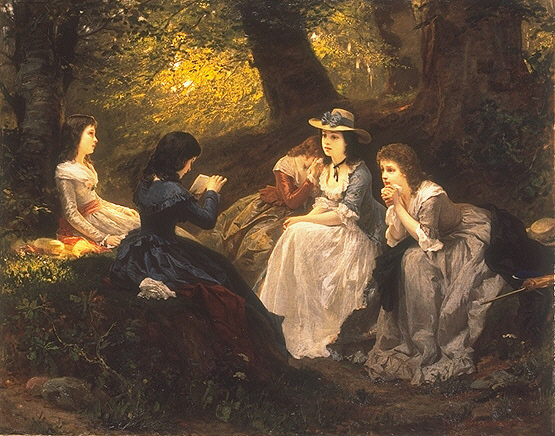Tuesday
I’m making a general report today on the final projects from my Theories of the Reader senior seminar. I’ll be reporting in detail in upcoming posts, but since at the moment I’m still frantically grading them (along with essays from my other classes), today I can provide only brief descriptions.
The students were to describe the “stir” caused by a literary work, either when it first came out or later, and figure out what the commotion teaches us about literature’s impact on people’s lives. It’s a conceptually challenging assignment because, in addition to researching the event, students must historicize the responses.
That is to say, they can’t always take those responses at face value. Different historical pressures and circumstances lead to certain reactions, which sometimes can only be understood in retrospect. To cite an example, Victorians may have embraced Coventry Patmore’s “Angel on the Hearth” in the mid-19th century because they were disturbed by social unrest, including increasing numbers of unmarried women. The dream of submissive wives, in other words, may have been in reaction to independent wage-earning women.
Here are the projects:
–Courtney Fielders looks at gendered responses to Streetcar Named Desire when it was initially staged in 1948. Male reviewers loved it while Mary McCarthy hated it, and Courtney wonders whether this was because men and women reacted differently to Stanley Kowalski’s rape of a woman he found fascinating and threatening.
—Raisin in the Sun was a hit amongst both black and white audiences when it was first staged in 1959, but Mindy Grant has discovered that it was popular for different reasons. She looks at those responses responses against the backdrop of the civil rights movement.
–Margaret Fletcher focuses on different generational responses to Goethe’s Sorrows of Young Werther, which was rumored to have triggered a suicide epidemic among young people. Margaret notes that there only three reported suicides, but that was still enough to panic parents, whom Margaret compares to parents of video game-playing teenagers.
–Dawn Coady examines discomfort amongst black parents about schools teaching Huckleberry Finn while Connor Campbell looks at Christian parents’ discomfort with Catcher in the Rye.
–Carly Wedding is interested in the fascination of youthful audiences in the early 1960’s for Jack Kerouac’s On the Road. Jessica Maddox, meanwhile, is looking at youthful audiences ten years later falling in love with Kurt Vonnegut’s Slaughterhouse Five.
–Allison Barrett wants to understand the popularity of Coventry Patmore’s Angel on the Hearth in the mid-19th century, and Zoe Smoeller looks at what about Wuthering Heights troubled readers around the same time, especially when they discovered it was written by a woman.
–Sabrina Wood tracks the up and down history of Solzenhitsyn’s A Day in the Life of Ivan Denisovitch, which Soviet authorities first allowed to be published and then banned.
–Ami Oliver examines why Margaret Atwood’s Handmaid’s Tale became the defining novel of feminism during the Ronald Reagan years.
–Noelle Gabelein sees to understand the popularity of Twilight and why children and their parents often had diametrically opposite reactions to the series.
—I reported this past Sunday on Abby Messaris’s exploration of the French church banning Moliere’s Tartuffe in the 17th century.
Consider these as previews of coming attractions.


